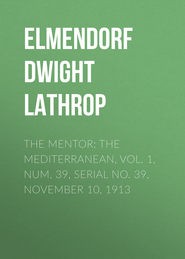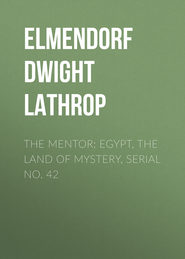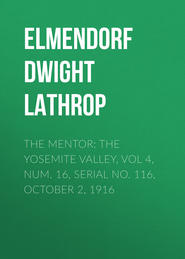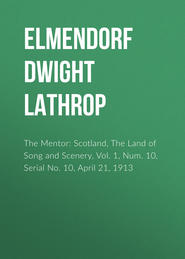По всем вопросам обращайтесь на: info@litportal.ru
(©) 2003-2024.
✖
The Mentor: Spain and Gibraltar, Vol. 1, Num. 31, Serial No. 31, September 15, 1913
Настройки чтения
Размер шрифта
Высота строк
Поля
The rock of Gibraltar has been for years the symbol of stability and of strength. It is in a military sense the “key to the Mediterranean.” It was taken by the British in 1704, during the war of the Spanish Succession, by Admiral George Rooke, who commanded the British fleet. It has been fortified by the English government in a manner that is most discouraging to anyone contemplating a hostile advance through the straits.
The shape of Gibraltar is that of an enormous lion. As Thackeray says, “It crouches there, to guard the passage for its British mistress.” At the base of the rock are batteries; up on the summit are guns of heavy caliber, and over its face are holes through which cannon muzzles look out across the water like sullen and malignant eyes.
Gibraltar is over 1,400 feet high and is composed of limestone. Under its present conditions of fortification it is declared to be impregnable. It looks it. At the foot of the great rock is a town of 30,000 inhabitants, of whom 6,500 are soldiers, composing the British garrison. In this town is to be found a cosmopolitan mixture of men, and the character of it shifts from time to time according to conditions of traffic through the straits. There is enough to entertain a visitor for a day. Life there for a long time must grow monotonous. The impressions, however, of a single day at Gibraltar are not forgotten. You carry away the conviction that, whatever might happen to anything else in this world, Gibraltar is likely to stay.
SUPPLEMENTARY READING
SPAIN AND GIBRALTAR
Toledo, the Ancient Capital
ONE
Rodrigo, last of the Gothic Kings of Spain, heard in his palace at Toledo that the Moors had crossed from Africa to Gibraltar. A little army led by Tarik landed in 711 and marched northward, conquering as it went. King Rodrigo, with a great force of Spaniards, met them in Andalusia. He commanded the center. The wings were led by King Witiza’s sons, who, hoping to recover the country that Rodrigo had taken from their father, joined the Moors, and pressed with them into battle. Rodrigo was surrounded and cut down. The Moors marched northward, taking city after city in the name of Mohammed, till all Spain was theirs. The last of the Gothic kings had fallen.
From that day to this Toledo has never regained her position as the capital of Spain. In the royal palace Tarik found twenty-five crowns of the old Gothic kings, golden and richly jeweled; the Psalms of David written on goldleaf with dissolved rubies, and the emerald table of Solomon. Those crowns may still be seen; but no one has ever seen the other treasures.
The Moorish kings, though they ruled Toledo mildly, had no end of trouble from the haughty nobility, who, robbed of their high position, were always in revolt against the conquerors. At last Sultan Hakim decided to punish his unruly subjects. He gave them a governor of their own race, who pretended to hate the foreigners, but was secretly in league with Hakim.
Amron soon won the hearts of his people and built a great castle in the middle of the city. There he held a reception for Prince Abd-er-Rahman, to which all the nobles and rich citizens of Toledo were invited. Feeling the honor of royal presence, which their city had not enjoyed for many years, the Toledans went by thousands to the castle. Told to enter one by one, noble and grandee went in – but not to feast. Five thousand lost their heads in the trap. Amron thought, no doubt, that it was a good joke; but he had not much time to enjoy it. When the people realized what he had done a mob gathered and burned his castle, with Amron in it.
Toledo was early freed from Moorish rule, and the greatest of those who helped to maintain her independence was Rodrigo Diaz the Cid, who, next to Napoleon, is held by many to be the foremost heroic figure in European history. He held important court offices under Alfonso, living in the Alcázar at Toledo. Many poems and stories have been written about the Cid. He belonged to a noble family, married the granddaughter of Alfonso V, and later made himself a king. The fate of a battle was never in doubt if the Cid was fighting; for his side was sure of victory. Toward the end of his life, after hundreds of battles and duels, he made his most famous conquest, the taking of Valencia from the Moors, in 1094. He ruled well and justly for the next five years over Valencia and Murcia, and in 1099 died of anger over the defeat of his favorite lieutenant. The Cid is Spain’s hero and saint, familiar to all in legend and in song.
SPAIN AND GIBRALTAR
Madrid, the Capital
TWO
Standing on the grand stairway of the Royal Palace, his hand upon the balustrade, and looking at the splendor about him, Napoleon Bonaparte said to his brother Joseph, to whom he had given the throne of Spain, “You are better housed than I am.” That was the emperor’s opinion of the royal residence in Madrid. To Napoleon the conquest of this ancient and famous land of Spain was one of his greatest victories.
Many people, when they first see the country around Madrid, are surprised at the lack of trees there. It is known that the mountains of that region were once covered with a heavy growth of forest which has since been cut away. The trees were felled to put money into the royal treasury. One reason they were never replanted is that many of the Castilians have a strong dislike for trees. They think only of the birds that nest among the branches and feed in grain fields; they forget that trees are both useful and beautiful in themselves, giving shade and moisture and beautifying the scenery.
In later years a wise government has come to see that the slight loss of farmland is not nearly so important as the effect woodlands have on climate. Groves now dot the landscape with patches of refreshing green, and the climate about Madrid is already improving. It is hoped that the bleak country, which now grows only a spare crop of corn, will become fertile and fruitful again when new forests have influenced a more regular rainfall and a steadier temperature. Scientific forestry can probably redeem the error that was committed centuries ago.
Madrid, though a modern city, has been from the beginning a center of art and literature. Velasquez went there from Seville to spend the greater part of his life. It was there that Cervantes, author of “Don Quixote,” lived and died. More important, perhaps, than any other figure in the Spanish drama was Lope de Vega, a native of the city. He led an eventful life while writing poems and plays with wonderful readiness. According to his own statement, more than a hundred of his plays were written so quickly that it took only twenty-four hours from the time he started to compose each one of them until it had been produced on the stage. He wrote 1,800 plays. He is said to have printed 21,300,000 lines, which, if we can believe his own account, was only a part of all that he wrote. To do this he must have written nearly nine hundred lines a day all through his life.
Many other artists and writers have worked in Madrid, and the Spanish capital is still a well known center of culture.
SPAIN AND GIBRALTAR
Alcázar at Seville
THREE
Tranquilly amid its gardens that glow with roses and orange blossoms, the Alcázar of Seville, palace of the old Castilian kings, stands now as it stood in the days of the Moors. Here and there a ceiling, a stairway, or a colonnade, damaged by fire or earthquake, has been repaired according to architectural ideas of more modern times; but in the main those Moorish kings who built it could sleep, if they were there today, in their own rooms undisturbed by any feeling of strangeness.
The site on which the Alcázar was built is probably the oldest in Seville. The palace replaces an old Gothic castle, which had been erected on the foundations of a Roman villa. Uncertain traditions and the imagination of historical writers have pictured the houses of shepherds on the same spot before history began.
There are many stories about the Alcázar, both true and fabulous. The Court of Maidens took its name from one of these. It was said that a tribute of a hundred maidens paid to the Mohammedan ruler had been lodged in that part of the Alcázar. History does not show that the calif ever asked for such a tribute, and it is probable that the Court of Maidens had not been built at the time when this incident is supposed to have taken place. Nevertheless, such a story has grown up, and has given the court a name that it will doubtless bear for all time.
After Castile had thrown off Moorish rule Seville was made the capital of Spain. For several centuries Christian kings lived in the Alcázar, adding somewhat to the original structure as the Moors had left it. The name of Pedro is more closely connected than any other Spanish ruler with the history and fiction of the building. He was called Pedro the Cruel. A grim sense of humor and a habit of going through the streets of Seville in disguise have made him the subject of many odd tales and rumors. Some of these stories are merely whimsical. He is said to have met four candidates for a judge’s position beside a pool in the gardens where they had gone to find him. Pedro, turning to the first, asked him what was floating in the pool.
“An orange,” replied the candidate without hesitation.
The second and third gave him the same answer.
The fourth fished out the piece of fruit with his staff, examined it, and replied more accurately, “Half an orange.”
Pedro immediately gave him the appointment.
SPAIN AND GIBRALTAR
Cathedral of Seville
FOUR
There is a Spanish proverb that says, “Whom God favors he gives a house in Seville.” The privilege of living in that bright, gay city is considered by a Spaniard to be the height of happiness. Other cities are larger, wealthier, or more important politically than Seville; but none holds a higher place in the hearts of the Spanish people. When in the beginning of the fifteenth century the old cathedral was damaged by an earthquake, a meeting was held to discuss what should be done to restore it. Then one proposed that, instead of repairing the old church, they should build a new edifice, larger and more magnificent than had ever been imagined. They planned a cathedral that should make all who saw it wonder at the daring of those who began it. What the public funds would not supply they agreed to furnish out of their own purses.
Only 117 years were consumed in the erection of this wondrous structure, which is a short time as old cathedrals go. After St. Peter’s at Rome and the Mezquita at Cordova, it is the largest church in the world. It is 414 feet long, 271 feet wide, and 100 feet high to the top of the nave. The immense pillars, as you look down the church between them, seem to diminish in the distance to the thickness of reeds. Many another cathedral could stand inside the nave of this one.
There are numerous churches in the city; most of the older ones are built on the foundations of mosques. The church of La Caridad has a strange legend connected with it. Don Miguel de Manara, the founder, had been a profligate in his youth, a sort of Don Juan, and was known far and wide for his excesses. One night when he was returning home alone he lost his way, and wandered about in a daze, unable to find his home. In imagination he met a funeral procession, and stopping one of the bearers inquired who it was that they were taking to eternal rest at such an hour.
“Don Miguel de Manara,” he replied.
Greatly surprised at hearing his own name, Don Miguel uncovered the face and saw there his own features. The procession immediately vanished; but left him so deeply impressed that he was converted and built a church and a hospital.
SPAIN AND GIBRALTAR
Siege of Granada
FIVE
The city of Granada was the last Moorish stronghold in Spain. The usurpers had been driven from province after province, while the power of Castile increased in all the country round. Only the province of Granada held firm. Even there, losses in war had so weakened the Moors that their kings paid tribute to the Christian rulers, down to the time of Muley Hassan. He was a proud and cruel monarch, so fond of the dignity his fathers had held that he not only withheld the tribute, but even made inroads into Spanish territory.
A ten years’ war followed. Spain determined to drive her enemy out of Europe once and for all. In battle after battle the Christians narrowed Hassan’s kingdom, till the people of Granada rose in revolt against the ruler whose bad luck and tyranny made him so unpopular. He was dethroned, and the kingdom given to Boabdil, his son. Boabdil was if anything more unfortunate than his father; for Ferdinand and Isabella pushed their conquest little by little up to the very walls of Granada.
A long siege followed. The Moors, as they lost the power they had held so long over the rich and delightful lands of Spain, tried every trick of warfare without effect. Ferdinand had given orders not to attack the city. He intended to win by starving his enemies rather than by fighting, while the Moors did all they could to provoke a battle. One daring knight named Yarfe rode out of the gates; unexpectedly he made his way to the Christian camp, and threw a spear into the ground close by the royal pavilion as an insult to Queen Isabella. In return Hernando del Pulgar, disregarding the order of Ferdinand, broke through the gates of Granada with a few followers and pinned a tablet on the door of a mosque with his dagger. Upon the tablet were the words, “Ave Maria.” Thus the knights of both sides showed their recklessness under the long siege.
The Spanish army lay so long encamped on the vega (plain) within view of the city walls and the magnificent buildings of the Alhambra that at last, after the tents had been accidentally burned, Ferdinand ordered a city to be built for the soldiers. Each of the towns of Spain sent its share of materials and in a remarkably short time Santa Fé, as it was called, stood side by side with Granada.
When all the vega was laid waste, when the Moors were starving and discontented, and a hostile walled city frowned in sight of the Alhambra, Boabdil at length made terms of peace. He said farewell to the palace of Moorish kings and all the luxuries he had enjoyed as its ruler, surrendered the keys of the city to Ferdinand, and went away greatly humbled. Never afterward did the Moors hold power in Spain.
SPAIN AND GIBRALTAR
Rock of Gibraltar
SIX











